#The one time he really takes initiative is when Tom and Gatsby are arguing
Explore tagged Tumblr posts
Text
do you ever think about how in The Great Gatsby Nick never really does anything of his own accord? how he’s always doing what others expected of him by others? because I sure do
#Like even him moving in next to gatsby!#That was something someone else wanted him to do!#The one time he really takes initiative is when Tom and Gatsby are arguing#And he’s like#“This seems personal maybe I should go”#And he’s immediately shut down!!!!#the great gatsby#axsotalke
21 notes
·
View notes
Note
dear GOD please infodump about the Gay™️ in The Great Gatsby, I'm begging you!
okay! here we go! buckle in ladies, gents, and distinguished entities, we’re going for a ride. (below the cut because it’s Long)
So, there are basically two lines of reasoning when it comes to gay subtext in The Great Gatsby: the historical context and the book itself. I want to establish that I haven’t cited that many sources for the history section (I usually would) because this part of queer history was very hidden and thus it’s very hard to find record of it. If anyone finds information that affects the validity of my theories, please let me know, and I’ll be happy to edit this post to make it more factual. All text excerpts are taken from The Great Gatsby by F. Scott Fitzgerald. (Also- this is your obligatory warning that this post discusses sexual content, so if that makes you uncomfortable, feel free to click away now.)
We’ll start with the history, more specifically a practice called “dropping hairpins.” Dropping hairpins essentially refers to signals that gay people, especially gay men, would use to “drop” hints about their sexual orientation. The point of these hidden phrases or signals would be to show other gay men that you were gay without outright admitting it, so that if the man you were talking to was actually straight, you wouldn’t be found out. These signals were mostly known only to gay men, so there was no risk of being outed unnecessarily. With this in mind, I’d like to take a look at the scene where Nick and another man are in an elevator.

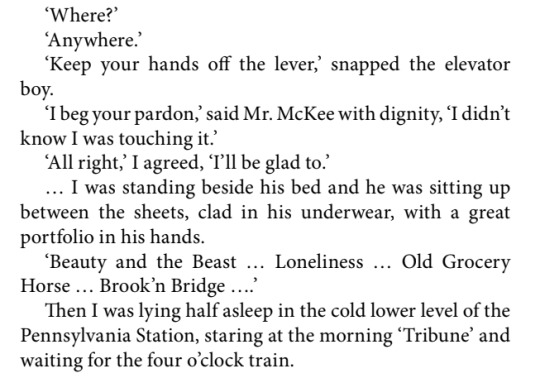
There’s obviously some build-up in the chapter previous to this moment, but Nick and Mr. McKee get in an elevator together. Mr. McKee, who Nick describes earlier in the chapter as “a pale feminine man,” asks Nick out to lunch with him, and then touches the lever for the elevator. In case you’ve never seen a lever in an old-fashioned elevator, it’s a round metal piece with a switch sticking out, sort of like this:
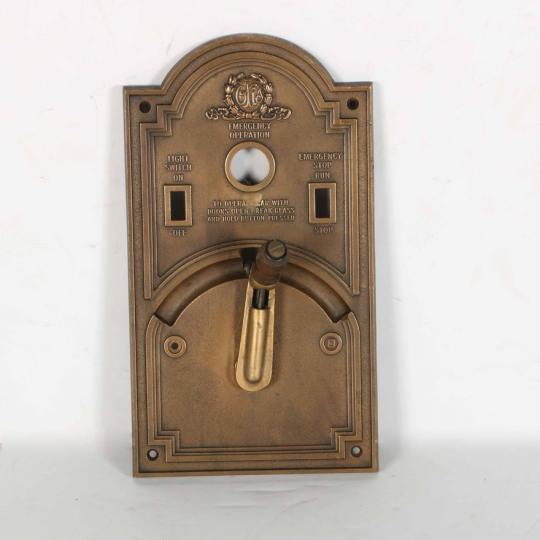
So… yeah. You can figure out the implications on your own. Additionally, there’s absolutely no reason why Mr. McKee would be touching the elevator lever. The elevator boy would be the one controlling the elevator at all times. The only reason for Mr. McKee to touch the lever would be to send some sort of sign. And it appears that he does- when we look at the text, some sort of understanding seems to pass between Nick and McKee after he touches the lever, since this is when Nick agrees to go to lunch with the McKees sometime.
After this exchange in the elevator comes the scene where Nick is next to McKee in his bedroom, with McKee on the bed, mostly undressed, and slurring his words as he talks. Given the signals that seem to have been exchanged between Nick and McKee in the last scene, I think it’s pretty clear what’s happening here. One could argue that Nick was helping McKee into bed, since they were both drunk in this scene, but there’s been no implications that McKee was so drunk he’d need assistance from a stranger- no descriptions of him as very intoxicated, or statements that he was stumbling or swaying on his feet. All of these details lead me to infer that Fitzgerald was implying some sort of sexual encounter between Nick and McKee. Also, bear in mind that this book was written in the 20s. No author would have been able to be straightforward about sexual content, especially not between people of the same gender. There’s a lot of reading between the lines that has to happen here.
Now, for my second line of reasoning: the language that Nick uses to describe different characters. In my observation, Fitzgerald tends to pick a distinctive feature for each main character and describe it in great detail, generally glossing over most of the other aspects of the character’s appearance. I’m not citing sections of text for this because it would take much too long, but (in my opinion), some of these features go as follows:
Daisy’s voice (and sometimes, her face)
Tom’s build
Jordan’s posture
Gatsby’s smile
The Great Gatsby is a book full of descriptions. Anything that Fitzgerald puts into the story has a very real reason to be there. I’d like to draw your attention to Nick’s initial description of various main characters in the story.
First, we’ll look at some of the women.
Daisy:
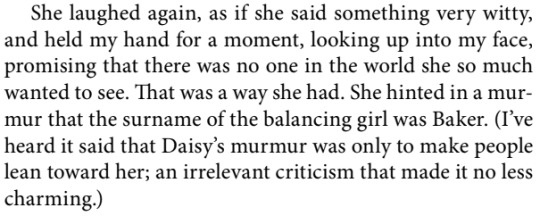
Jordan:
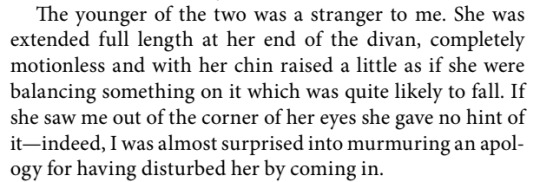
Myrtle:


And now, we’ll look at some of the men.
Tom:

Wilson:

Gatsby:
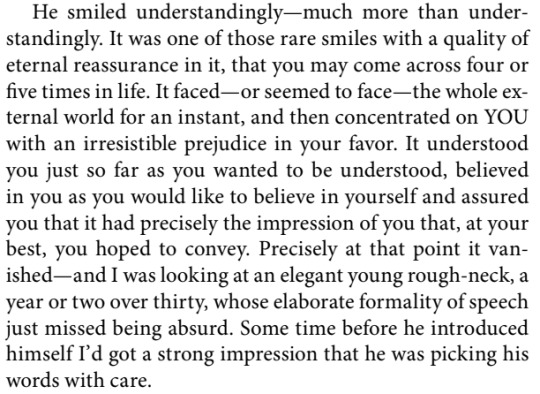
There are definitely a lot more examples I could pull here, but I think that this establishes the trend well enough. There’s a discrepancy between how Nick describes men and women in this book: he describes Tom’s body in vivid detail, spends an entire paragraph detailing the warmth and beauty of Gatsby’s smile, and even calls Wilson “handsome.” On the other hand, women don’t get this same treatment. Although he dates Jordan, the nicest thing Nick has to say about her appearance throughout the majority of the book is that he “liked looking at her,” and he describes Myrtle as not being beautiful at all. The woman he describes the most favorably is Daisy, and she’s his cousin. And because of this, Nick displays a lack of interest in women that is pretty constant throughout the book. I also want to reiterate that this book was written a century ago. The fact that Nick dated Jordan doesn’t really prove anything in my opinion (although if you personally interpret Nick as bi, that’s valid!) because I interpret his language as portraying a disinterest in their relationship, and in most women in general.
(anyway, i could go into even more detail here, but this post is getting absurdly long. sorry it took me so long to answer your ask! i hope the length makes up for it. also i bet most of you never thought you’d see me use proper capitalization- i did it to make the post easier to understand.)
#thank you so much for the ask!#this took forever to write but it was really fun#can y'all tell it's gatsby reread week#anyway i love nick carraway bye#my post#asked and answered#infodump#the great gatsby#jay gatsby#nick carraway#tom buchanan#daisy buchanan#george wilson#myrtle wilson#jordan baker#f. scott fitzgerald#fitzgerald#classic lit#literary analysis#el rambles on
92 notes
·
View notes
Text
The American Dream: Shining Light or Complete Conspiracy
The American Dream: This notion that you can come to America and create any life you want has existed in the hearts of countless Americans. Yet, the dream’s validity has been debated for scores. Satirical comedian George Carlin in comedy clubs claimed it earned its title because “you have to be asleep to believe it.” In 1925, F. Scott Fitzgerald wrote, The Great Gatsby whose theme contended that the American Dream was unattainable and chasing it would destroy you. However, there have also been champions of the dream’s reality. In the 1800s, poet Walt Whitman wrote works speaking of the ability for everyone to succeed. In more recent years, the television show, King of the Hill gave their take on the American Dream in, “The Redneck on Rainey Street”. The episode contends that although the voyage to attaining the American Dream is imperfect, the American Dream is attainable and one cannot choose to give up on making that dream come true. The thematic statements about the American Dream retained in The Great Gatsby and in “The Redneck on Rainey Street” are vastly different; one argues for the unattainability of it while the other defends the dream’s honor.
Within The Great Gatsby, F. Scott Fitzgerald argued the unattainability of the American Dream in the wake of the first World War and the Great Depression. Fitzgerald uses Jay Gatsby as a symbol of those who fail at aspiring to achieve the dream. “‘Jimmy was bound to get ahead’” stated Gatsby’s father when examining Gatsby’s boyhood schedule (Fitzgerald 173). The boyhood schedule symbolized Gatsby’s aspirations to escape the meager, agrarian life that he came from. However, even after becoming extraordinarily wealthy, Gatsby was still a member of the new money caste which dwelled in West Egg; East Egg only housed those who were from old money. West Egg was “the less fashionable of the two, though this is a most superficial tag to express the bizarre and not a little sinister contrast between them” (Fitzgerald 5). The symbolic nature of the two eggs is to demonstrate how old money doesn’t admit those of new money into their exclusive cult. The only way to enter the social elite is to marry into it; however, Gatsby, not cut from the same cloth as Daisy Buchanan, stood no chance of doing so. Daisy, “high in a white palace, the king’s daughter, the golden girl” was Gatsby’s ticket to that prestigious class (Fitzgerald 120); “’her voice’” was “’full of money’” (Fitzgerald 120). Because of the canon of the social elite, “she married Tom Buchanan”; he was a member of the Southern Aristocracy but Gatsby wasn’t (Fitzgerald 76). The argument Fitzgerald was making by showing Gatsby’s inability to win Daisy back is how the societal elite maintain exclusivity because money doesn’t grant you access to their private club and you cannot marry into it either. The entirety of Gatsby’s dream is allegorical to the American Dream; the green light within the work symbolizes this allegory. “Gatsby believed in the green light, the orgastic future that year by year recedes before us. It eluded us then, but that’s no matter—to-morrow we will run faster, stretch out our arms farther…. So we beat on, boat borne against the current, borne back ceaselessly into the past” (Fitzgerald 180). Fitzgerald’s central point was that this perpetual striving for the American Dream is as pointless as a dog chasing after its own tail; this is no different than the outcome of Gatsby who died at the end of the novel. The central theme which Fitzgerald presented in his novel was that the American Dream is unattainable and chasing after it will end in your demise.
Transitioning away from 1920s novels and entering modern 2000s television brings us to “The Redneck on Rainey Street” and its take on the American Dream. During the episode, the Souphanousinphones descend into a white trash lifestyle after feeling cheated out of the American Dream. For some background, King of the Hill is a television show set in a Texas suburb. The main protagonist is Hank Hill who is an archetype of the working-class breadwinner and family man. The Souphinousinphones are a family who live next door. The family, consisting of Kahn, Minh and Connie emigrated from Laos; this episode focuses around them. The episode commences with Kahn becoming disappointed when he learns about Connie not getting accepted into a summer program at Rice University. When he approaches the program director at Rice, she tells him that “‘Connie is a really smart Asian girl’” (Dauterive). Kahn is frustrated by this because Connie has perfect grades, numerous extracurriculars, and hours of community service; yet she expurgated because of a racial quota. The episode continues and when Kahn stops to refuel his car, he is approached by Elvin Mackelston, a redneck who asks questions about Kahn’s life. During their interaction, Mackelston talks about how he was “’just like’” Kahn and was “’a monkey in a cage’” (Dauterive). Eventually, Elvin asks Kahn if he is “’rocking in the free world’” (Dauterive). Kahn, out of his frustration with the system, chooses to abandon his pursuit of the American Dream to become a redneck. Kahn’s justification for his action is explained when convincing Minh that they should just give up; he claims that “’there is a paradise out there where nobody works, nobody cares, where nobody has hopes or dreams that can be crushed’” (Dauterive). He continues and claims “’ this is for Connie, so that she doesn’t spend half her life losing at their rigged game’” (Dauterive). Minh proceeds to agree and the two decide to become rednecks; the duo proceed to participate in stereotypically redneck outings like shooting squirrels off telephone poles and attending late-night, red-dirt music concerts. However, in these scenes, you also observe blatant foreshadowing of impending disaster as final notices for their mortgage bill appear on screen. Finally, a turning point arises when Kahn, Minh, and some other rednecks decide to burglarize a music store to acquire Trace Atkins’s new album. When Kahn picks up a rock to pulverize the window, Minh warns him that if the “’rock goes through window’” she will go home (Dauterive); this demonstrates how acting foolishly can lead you down a dangerous and potentially illegal road. During the climax of the episode, Hank Hill the series’ main protagonist, approaches Kahn during a stick fight to talk some sense into him. Kahn initially asserts that “’everything already been taken away’”, so he doesn’t care anymore (Dauterive). Kahn goes on to claim that his family had to flee a “horrible dictatorship, learn a new language, and then work hard and study hard. And our (their) reward for doing everything right is (was) to be told, go to hell! You work too hard! You study too hard!” (Dauterive). Hank then asserts that Kahn “’got a real bum deal but’” maybe Kahn could “’take a lesson from Connie instead of these apes (the rednecks)’” because even when her parents “’went off the deep end she never complained and she never stopped trying’” (Dauterive). Kahn then has an epiphany about how you cannot wallow in self-pity after feeling cheated. From this, “The Redneck on Rainey Street” asserts that although the American Dream is sometimes hard to attain, wallowing in you own self-pity and giving up will only result in guaranteed failure because you can reach the dream if you work hard enough.
The Great Gatsby and “The Redneck on Rainey Street” clearly present completely different thematic statements regarding the American Dream; Fitzgerald wrote about the unattainability of the dream while Jim Dauterive presented the necessity to persevere and achieve success in America while noting the long, arduous journey to attain the dream. Fitzgerald clearly argued that the American Dream is unattainable and chasing after it will end in your demise. Dauterive and the King of the Hill staff take a different approach and assert that the path to the American Dream can be riddled with trials and tribulations, yet because the dream is still accessible choosing to give up will only lead you to a worse place. Furthermore, this humble television production presents a more full-circle view of the American Dream than Fitzgerald in a millennium could dream of presenting. Like it or not, the agency of an individual is the most vital ingredient to acquire the American Dream. “The Redneck on Rainey Street” exquisitely demonstrates this fact; when Kahn decided to become a redneck, it was his actions that resulted in him nearly losing his house. Connie, in contrast, chose to not allow her parent’s immature actions to derail her scholarly endeavors; she was later rewarded for this by being accepted to Stanford’s summer school program. The Great Gatsby argues, with disturbing conviction resulting in contempt from readers in some instances, that an individual’s own agency doesn’t matter because the elite would never allow you to succeed in this nation. This message although comforting in the wake of economic downturns, such as the Great Depression, is far from true and is never helpful. The best message for anybody to hear in the wake of losing everything or in the face of adversity is that they already possess an arsenal of Snap-on tools to handle the task in front of them; it is this message of empowerment that makes the American Dream a reality.
Works Cited
Dauterive, Jim. “The Redneck on Rainey Street.” King of the Hill , season 8, episode 21, Fox, 16 May 2004, www.youtube.com/watch?v=3hOnASjbpvQ.
Fitzgerald, F Scott. The Great Gatsby. Everbind, 1925.
1 note
·
View note